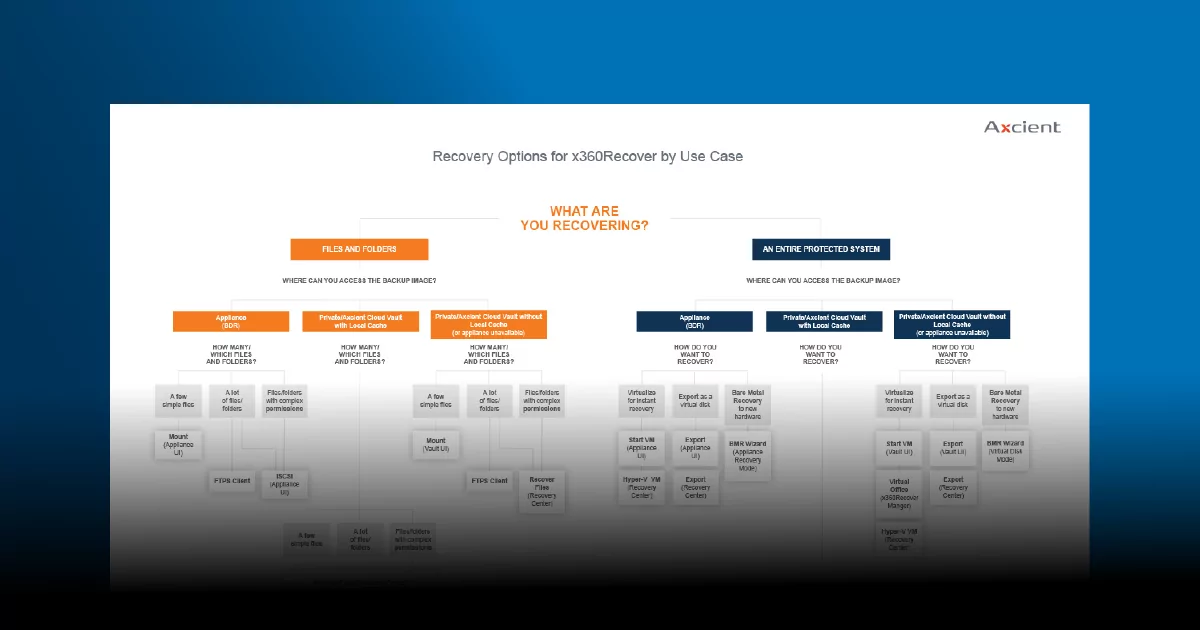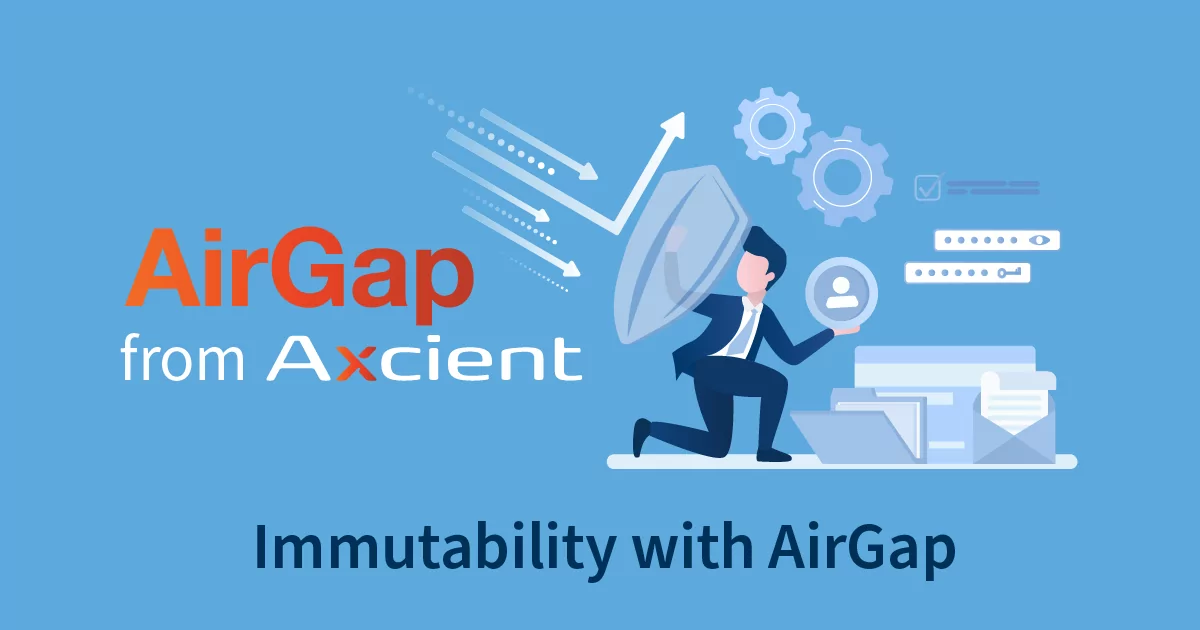
What MSPs Need to Know About Linux Support
While Windows support has become a priority for most MSPs, Linux use is rising, with many industry leaders anticipating further growth in the upcoming years. The advent of the Linux operating system (OS) presents challenges and opportunities for MSPs choosing to support these systems as part of comprehensive business continuity and disaster recovery (BCDR) services.
As MSPs know all too well, the cybersecurity and IT needs of SMBs ebb and flow quickly depending on changing trends, new technology, and increasing attacks. Consolidated efficiency remains today’s gold standard for high-performance MSP operations, data security, and profitability, but many continue juggling disparate solutions across various vendors.
This article covers Linux basics, shows where the trend is headed, and discusses what MSPs can do to capitalize on increased use with built-in efficiency.
Table of Contents
What is Linux?
Linux, an open-source operating system, was first developed in 1991. Since then, it has evolved into a powerful and versatile platform that underpins a wide range of computing systems, from personal computers and servers to embedded devices and supercomputers. This growth has been fueled by a global community of developers and companies, making Linux a significant force in the technology world.
At its core, Linux OS is composed of the Linux kernel, the central part of the operating system that manages hardware resources and enables communication between software and hardware components. Surrounding the kernel are various system utilities and libraries that provide essential functions and user interfaces, forming a complete operating system.
One of the most remarkable aspects of Linux is its open-source software. The free availability of the Linux source code fosters collaboration that encourages developers to contribute improvements, fix bugs, and create new features. The result is a system that is constantly evolving and improving. Moreover, open source allows for extensive customization, empowering users to shape the system to their specific needs.
Linux is known for its stability, security, and efficiency, making it a popular choice for server environments, including web servers, database servers, and cloud infrastructure. The operating system powers many of the world’s supercomputers and is the backbone of the Android OS running on billions of mobile devices.
Linux as a Rising Third Choice for Operating Systems
Yes, Windows and macOS continue to be the most popular operating systems, but Linux use is rising as a third choice. Rather than continuing to use the operating systems that ship with most desktops, laptops, and servers, SMBs are starting to look outside the box for “better” systems.
“In organizations, the average device type breakdown is Windows 60% (down from 64% in April 2023), macOS 22% (up from 20%) in April 2023), and Linux 22% (up from 16% in April 2023). …31% anticipate Linux use to increase (up from 26% in April 2023).”
– State of IT 2024, JumpCloud
Many are choosing the Linux operating system for the following reasons:
- Cost-efficiency: As an open-source OS, Linux doesn’t require the expensive licensing fees associated with proprietary operating systems like Windows and macOS. The Linux server is freely accessible and easy to install with just a few clicks or commands.
- Performance: Known for its robustness and ability to run efficiently on older hardware, Linux gives SMBs confidence while reducing the need for frequent hardware upgrades and associated costs. This level of reliability delivers minimal downtime, which is crucial for SMBs to maintain business continuity.
- Customization: SMBs can tailor the OS to meet their specific needs, industry, and clientele, creating a streamlined and efficient setting to do business. Linux adaptability further extends through various available distributions (“distros”), or versions of Linux, that fit individual requirements. The growing ecosystem of applications and support for Linux makes it a viable OS for many business applications, from web servers to office productivity tools.
Meeting Client Needs in an Expanding Linux Support Market
As an MSP, it’s your responsibility to provide uninterrupted business continuity, rapid disaster recovery, cybersecurity, and compliance to keep your clients’ businesses running. That doesn’t mean MSPs need to serve every SMB’s needs, but as Linux users continue to expand, MSPs are presented with an opportunity and a challenge.
MSPs can expand BCDR services to include Linux support to win more clients, but adding another OS may stress complex stacks, add to tech debt, and increase operational overhead. On the other hand, MSPs can maintain BCDR services without Linux support and hope the trend fades – but that could cause a drop in business and make it difficult to win new clients if Linux popularity continues. Regardless, if you’re not protecting Linux, you’re not providing business continuity to clients who use Linux.
Linux systems, while secure, are not immune to cyber threats like ransomware, hardware failure, human error, or natural disasters. Like Windows and macOS, the Linux operating system is critical in business environments where data integrity and uptime are paramount. Clients risk losing valuable data, money, and reputation without a proactive BCDR solution and BCDR plan for Linux support. Moreover, industries subject to strict data protection standards and cyber insurance requirements for MSPs mandate regular backups and disaster recovery plans. A client using the Linux OS must be protected to ensure business continuity. Compliance with these regulations is crucial to avoid legal penalties and maintain client trust.
Unfortunately, the complexity and diversity of Linux environments can be difficult for SMBs to manage in-house. Often requiring specialized knowledge and tools to manage backups effectively, SMBs look to MSPs for help. MSPs taking advantage of the Linux trend can apply their expertise to design and implement tailored BCDR strategies that address the unique challenges of Linux OS. Not only do you provide clients with peace of mind, but you also create a new revenue stream to drive profitability.
Navigating Linux Support Complexity with Consolidated Efficiency
The benefits of offering Linux support are apparent, but the challenges can be daunting for many MSPs. How do you add support for a new operating system without inflating labor costs and overhead expenses? The answer is an all-in-one BCDR solution that supports Linux without requiring a new product or vendor to manage.
Best-in-class MSP vendors are responding to the channel’s call for consolidated efficiency by building new capabilities on a single BCDR foundation. With this expansive strategy, MSPs can support Linux within the same platform used for Windows and macOS. Focusing on flexibility for MSPs, channel-specific vendors regularly develop new capabilities, features, and protections within BCDR platforms to extend capacity without adding confusion and cost.
With that said, just supporting Linux isn’t enough. MSPs must balance Linux while maintaining high standards for other operating systems, SLAs, RTO, and RPO to deliver high-quality cybersecurity regardless of client environments. Leveraging products that utilize Chain-Free backup, automation, disaster recovery testing, in-depth reporting, public APIs, straightforward pricing, and pooled storage, MSPs can offer more services while maintaining budgets and keeping technicians happy. Sadly, many MSPs struggle to find a vendor and product capable of delivering these outcomes.
“In short, MSPs say inefficient systems cost more to operate, hamper sales, and lower revenue generation. In their experience, BCDR inefficiency is expensive. Unfortunately, 33% said they can’t consolidate on a single BCDR platform because they can’t find one that meets all of their needs or because they’re unaware of their options.”
– Research Report: MSPs and BCDR Optimization, Axcient and Channelnomics
MSP Linux Support for Backup and Recovery of Linux-Protected Systems
If you’re unfamiliar with Axcient, you’re probably one of the MSPs struggling to find that all-inclusive BCDR platform required for streamlining stacks. Axcient is a 100% MSP-dedicated solutions provider of comprehensive BCDR for the channel. Axcient x360 provides one platform for MSPs to protect everything, including BCDR with x360Recover, Microsoft 365, and Google Workspace backup with x360Cloud, as well as secure sync and share with x360Sync. Developers incorporate MSP feature requests into Axcient’s technical roadmap to continuously enhance products based on actual MSP feedback. A more innovative, more reliable BCDR for nearly all MSP use cases, x360Recover supports Windows, Linux, and, coming soon, macOS.
Axcient x360Recover for Linux
x360Recover for Linux BCDR provides MSPs with full image-based backups for end-user desktops, laptops, client servers, and workstations. Regardless of how x360Recover is deployed – with an appliance or without using x360Recover Direct-to-Cloud (D2C) – the Linux agent offers analysis tool support, agent orchestration for configuration management, file and folder recovery, bare metal restores (BMR), and full-image recovery via BMR. The x360Recover agent for Linux devices supports Ubuntu, Debian, RedHat, and CentOS.
Axcient’s Linux agent…
- Integrates seamlessly with various Linux distributions, simplifying the complexities of supporting multiple versions. This compatibility allows MSPs to standardize BCDR processes across different Linux environments, reducing operational overhead and technical debt.
- Offers advanced management tools and automation capabilities, enabling MSPs to efficiently manage backups, monitor system health, and perform recovery tasks. These tools reduce the need for specialized Linux expertise, allowing MSPs to deliver robust support with greater ease.
- Employs simple pricing per server and device. Because the Linux backup agent is for servers, backing up a Linux workstation with it will be billed as a server and priced the same as x360Recover. Say “bye-bye” to surprise fees and continuously rising costs when you break free from tiered pricing.
- Includes pooled storage at a flat fee, where most MSP use cases fall below the cap on the Fair Use Policy. Axcient allows each server cloud backup to add 3TB to Fair Use Cloud Storage, and each desktop cloud backup adds 300GB to Fair Use Cloud Storage. When pooled, few MSPs exceed the data storage limits.
Final Thoughts
As the operating system landscape progresses, Linux is emerging as a compelling choice for SMBs seeking cost-effectiveness, stability, security, and customization. It’s in the best interest of MSPs to adapt to the Linux trend by offering complete backup and disaster recovery for Linux OS. However, the diversity and complexity of Linux distributions and the need for specialized knowledge and tools pose significant challenges for MSPs.
To effectively support Linux environments, MSPs need a comprehensive data protection solution like Axcient x360Recover for Linux to ensure business continuity and rapid disaster recovery. Its compatibility with various Linux distributions simplifies the management process, while advanced security features meet stringent compliance and cyber insurance requirements. The automation and management tools reduce the burden of specialized expertise, enabling MSPs to deliver vital support efficiently. By integrating x360Recover into service offerings, MSPs can address the unique challenges of Linux support, safeguard client data, and ensure uninterrupted business operations. Embracing this solution enhances client satisfaction and opens new revenue streams, positioning MSPs for success in a market increasingly inclined toward Linux.
Additional Resources
Axcient’s Linux for x360Recover Knowledgebase contains the following resources and more to help you decide how best to support Linux OS.
Watch a demo of Linux for x360Recover (or skip to the most valuable parts): Linux backup installation from an appliance and Linux BMR from an appliance.
Author
Related posts
How well could you sleep with reliable cloud-based backups and recovery?
Take a deep dive into Axcient’s proprietary, automated security features to see how we’re ensuring uninterrupted business continuity — no matter what:




